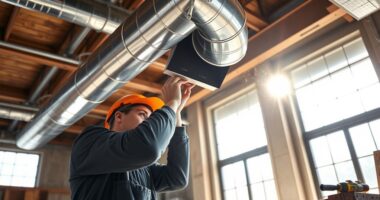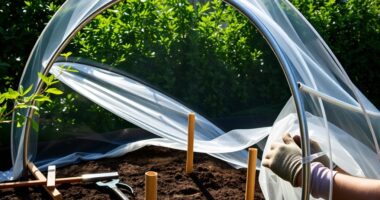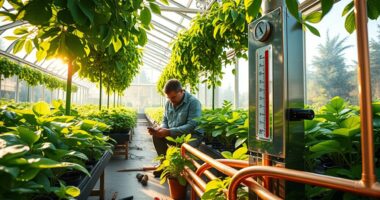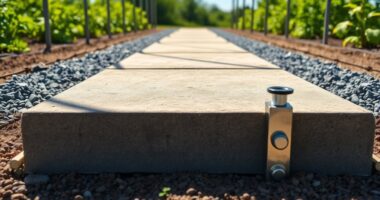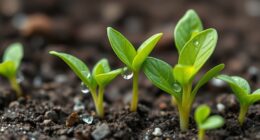Constructing a freestanding greenhouse has its benefits and challenges. You’ll enjoy flexibility in design and year-round gardening, but initial costs and maintenance can add up. Effective temperature and humidity management is vital, and you may face pest issues due to isolation. Security concerns might arise, too. Balancing these pros and cons is essential for success. To better navigate your choices, exploring key design considerations and cost implications is a great next step.
Key Takeaways
- Freestanding greenhouses offer flexibility in design and location, enhancing sunlight exposure and ventilation for optimal plant growth.
- Initial costs can be high, and ongoing maintenance is required to manage temperature, humidity, and structural integrity.
- They provide isolation from home pests but may present increased risks of theft and accessibility issues.
- Customizable settings allow for effective microclimate management, supporting diverse plant cultivation year-round.
- Weighing the advantages and challenges is essential for making informed decisions on greenhouse investment and management.
Overview of Freestanding Greenhouses

Freestanding greenhouses are versatile structures that can enhance your gardening experience by providing a controlled environment for plant growth.
These independent buildings can be placed anywhere in your garden and come in various shapes and sizes, from small hobby models to expansive commercial systems. You’ll find designs like quonset, gothic, and gable roofs, each offering unique benefits.
Typically made with durable metal frames, they can be covered with either plastic or glass, affecting light transmission and insulation.
Freestanding greenhouses allow you to extend your growing season, protecting plants from harsh weather.
Advantages of Freestanding Greenhouses

When you’re considering a greenhouse, the advantages of a freestanding model can considerably enhance your gardening experience.
You’ll enjoy flexibility in design and location, as these greenhouses come in various sizes and shapes to suit your needs. Placing it anywhere on your property optimizes sunlight exposure and avoids obstacles, even in unlevel terrain.
Freestanding structures guarantee uniform light distribution and better ventilation, allowing you to create ideal climates for different plants. They’re also cost-effective, especially for smaller growers, and simplify maintenance.
Plus, the aesthetic appeal can complement your landscape, while providing year-round gardening opportunities.
With the independence of each structure, you can customize settings and manage microclimates effectively, making them a versatile choice for any gardener.
Disadvantages of Freestanding Greenhouses

While the benefits of freestanding greenhouses are enticing, several disadvantages can impact your gardening experience.
First, the initial costs can be high, as you’ll need a complete structure and additional infrastructure for power and water.
Once set up, you’ll face increased maintenance and vulnerability to weather damage.
The open design leads to higher heat loss, making temperature control a challenge in extreme conditions.
You might also need to deal with pests more frequently due to isolation.
Accessibility can be an issue if the greenhouse is far from your home, and snow accumulation could pose risks.
Ultimately, the potential for theft means you’ll need to implement extra security measures, adding to your overall investment.
Key Design Considerations

When designing your freestanding greenhouse, you’ll want to prioritize structural integrity to withstand various weather conditions. Efficient ventilation systems are also essential to maintain ideal temperatures and humidity levels for your plants. Additionally, incorporating proper insulation techniques will help regulate temperature fluctuations, creating a thriving environment for your crops.
Structural Integrity Requirements
To guarantee a freestanding greenhouse remains structurally sound, several key design considerations must be addressed.
Start with a solid foundation; use concrete with a 2,500 PSI mix that extends below the frost line to handle various loads like wind and snow. Consulting experienced builders assures durability.
Next, choose your framing material wisely—aluminum is low-maintenance and durable, while steel offers strength but needs protection from moisture.
Ascertain rafters are spaced appropriately, and incorporate purlins and cross ties for added stability.
Finally, consider your glazing options; polycarbonate and acrylic provide good durability and light transmittance.
Adapting your design to local climate conditions is essential for long-term success.
Efficient Ventilation Systems
Maintaining structural integrity in your freestanding greenhouse sets the stage for effective ventilation, which is essential for plant health.
You’ve got two main options: natural and mechanical ventilation. Natural systems are energy-efficient and cost-effective, while mechanical systems guarantee consistent airflow and cooling. For ideal performance, integrate your ventilation with other greenhouse systems.
Keep roof vents strategically placed to let hot air escape and use side vents to draw in cool air.
Consider automatic vent openers, which can be solar-powered. Don’t forget shading techniques to prevent overheating.
Finally, guarantee continuous air circulation to avoid condensation and maintain even temperatures. Proper ventilation practices will ensure your plants thrive when you prioritize these key design considerations for efficient ventilation systems.
Ideal Location and Orientation

Choosing the right location for your greenhouse is essential for maximizing sunlight and protecting it from harsh winds.
You want to guarantee it gets plenty of sun exposure while being shielded by natural barriers.
A well-placed greenhouse can thrive and enhance your gardening experience.
Sunlight Exposure Importance
Where should you position your freestanding greenhouse to maximize sunlight exposure?
Ideally, you want a south-facing orientation, as it captures the most sunlight throughout the day.
If you orient the greenhouse from east to west, you’ll benefit from sunlight traveling across the broader side, which is great for plant growth.
Avoid north-facing locations, as they receive minimal sunlight, particularly in winter.
Be mindful of nearby structures that could cast shadows during peak hours.
Use sun path charts to assess seasonal changes and adjust your greenhouse orientation accordingly.
This strategic positioning not only enhances photosynthesis but also helps create a favorable microclimate, ensuring your plants thrive year-round.
Wind Protection Strategies
To effectively protect your freestanding greenhouse from wind, consider its location and orientation carefully.
Position it near natural windbreaks like hedges or buildings to reduce wind impact, but avoid excessive shading that could harm plant growth.
Understand the prevailing wind direction to minimize exposure, keeping a safe distance from windbreaks to prevent debris fallout.
For orientation, a southern-facing greenhouse offers sunlight but may also face strong winds; consider east or west orientations for better wind protection.
Remember to reinforce the structure with internal bracing and secure the base to enhance stability.
Regularly inspect your greenhouse for damage, and have materials ready to cover vulnerable areas during extreme weather.
Construction Requirements

Before you plunge into constructing your freestanding greenhouse, it’s vital to contemplate several key requirements that will guarantee its success.
Addressing these aspects will set you up for a flourishing garden.
- Location Selection: Choose a spot with maximum sunlight, ideally south or southeast-facing.
- Zoning and Permits: Research local regulations and secure necessary permits before you start.
- Foundation Requirements: Decide on a durable foundation, like concrete for larger structures or timber for smaller ones.
- Framing Materials: Opt for lightweight, rust-resistant materials like aluminum or steel for strong framing.
Maintenance Practices

Once you’ve established the construction requirements for your freestanding greenhouse, you’ll want to focus on maintenance practices that guarantee its longevity and productivity. Regular checks on temperature and humidity levels are crucial, so consider setting up automated systems for alerts. Inspect the structural integrity frequently, confirming frames and bracing are secure. Don’t forget ventilation; lubricate moving parts and verify vents close tightly. As for pest control, inspect plants regularly and clean surfaces to prevent disease spread.
| Task | Frequency | Purpose |
|---|---|---|
| Temperature Checks | Daily | Optimize plant growth |
| Structural Inspections | Monthly | Confirm stability and safety |
| Ventilation Lubrication | Bi-Annually | Maintain system efficiency |
| Pest Inspections | Weekly | Detect and isolate issues early |
| Surface Cleaning | Bi-Weekly | Prevent disease spread |
Cost Implications

When evaluating a freestanding greenhouse, understanding the cost implications is essential for making an informed decision. Your initial investment can vary widely depending on several factors.
Evaluating a freestanding greenhouse requires understanding the varied cost implications for an informed investment.
Here are some key cost aspects to evaluate:
- Size and Design: Expect to pay between $5 to $35 per square foot, depending on complexity.
- Materials: PVC is the most affordable, while aluminum and steel can drive costs up.
- Location and Climate: Additional heating or cooling features might be necessary, impacting your budget.
- Labor and Permits: Don’t forget to factor in labor costs and any necessary permits to avoid surprises.
Final Thoughts on Freestanding Greenhouses

As you weigh the benefits and drawbacks of a freestanding greenhouse, it’s important to contemplate how it aligns with your gardening goals and lifestyle.
The design flexibility and customization options can enhance your growing experience, allowing you to cultivate a variety of plants year-round.
However, consider the potential challenges, like higher heating costs and accessibility issues. You’ll need to manage humidity and temperature carefully to maintain plant health.
While the isolation from your home can reduce pest risks, it also raises security concerns.
Ultimately, if you’re willing to invest time and resources into maintenance and management, a freestanding greenhouse can be a rewarding addition to your gardening endeavors, providing the space and environment needed for thriving plants.
Frequently Asked Questions
What Types of Plants Thrive Best in Freestanding Greenhouses?
If you’re looking to fill your freestanding greenhouse, consider tropical plants like orchids and palms for their beauty and air-purifying qualities.
For year-round production, citrus trees and tomatoes thrive in controlled environments.
If you prefer low-maintenance options, succulents like aloe vera and Haworthia are excellent choices.
Don’t forget exotic plants like African violets and ferns, which flourish in high humidity.
Each type can create a vibrant and diverse greenhouse environment!
Can I Use a Freestanding Greenhouse Year-Round?
Yes, you can definitely use a freestanding greenhouse year-round!
With the right design and features, it allows you to maintain an ideal growing environment. Make sure to incorporate insulation, effective ventilation, and proper glazing to regulate temperature.
You’ll also want to select cold-hardy plants for winter and consider supplemental heating for tropical varieties.
How Do I Manage Pests in a Freestanding Greenhouse?
Imagine your freestanding greenhouse as a fortress, protecting your plants from pests. To manage them effectively, start by monitoring regularly for signs of trouble.
Use insect screens to keep invaders out and sticky traps to catch flying pests. Introduce beneficial insects like ladybugs to combat aphids.
Are There Any Zoning Restrictions for Freestanding Greenhouses?
Yes, there are zoning restrictions for freestanding greenhouses.
You’ll need to check your local regulations, as they can vary widely by community. Some areas require greenhouses to be a certain distance from lot lines, often around 20 feet.
Additionally, your neighborhood might’ve rules about the number of accessory buildings you can have.
It’s essential to consult local zoning authorities to guarantee you’re compliant before starting your greenhouse project.
What Tools Are Essential for Building a Freestanding Greenhouse?
To build a freestanding greenhouse, you’ll need several essential tools.
Start with a power drill for assembling the frame and a miter saw for cutting wood. Keep a hacksaw handy for precise cuts and use scissors for plastic sheeting.
A measuring tape guarantees accurate dimensions, while a hammer and nails secure wooden parts.
Don’t forget utility knives for small adjustments and sealant to prevent leaks.
These tools will help you create a sturdy greenhouse.
Conclusion
In the end, choosing a freestanding greenhouse can be a game-changer for your gardening journey. Picture yourself nurturing vibrant plants year-round, but don’t forget the challenges that come with it. Will the benefits outweigh the drawbacks? As you weigh your options, consider the design, location, and maintenance. Your dream greenhouse could be just a decision away. So, are you ready to reveal the potential of your garden with a freestanding greenhouse? The choice is yours!


